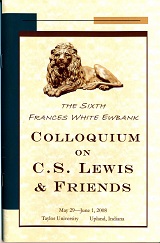Event Title
Session 1-B: C.S. Lewis...And Friends
Location
Taylor University, Metcalf 104
Start Date
29-5-2008 3:30 PM
Description
The Abolition of Man in Retrospect" - Paul Michelson
This paper reviews some of the principal contentions of C. S. Lewis’ The Abolition of Man (1943) and assesses their status, relevance, and importance 65 years on.
Reflections of the New Man in The Chronicles of Narnia - Pamela Jordan
A recurring theme in The Chronicles of Narnia is that Narnia changes those who enter. The narrator repeatedly notes the restorative power of Narnia and calls the reader's attention to the difference in the children (and adults in The Magician's Nephew) that results from spending time in the world Aslan sang into being. In Narnia we are more of who we can be; we realize our potential. This theme is expressed in each of the Pevensie children, but comes through most clearly in Edmund. His visit to Narnia and personal encounter with Aslan transform him. Thus, the Edmund we see in Prince Caspian is very different than the Edmund we meet in The Lion, the Witch and the Wardrobe.
"C.S. Lewis and Frederick Buechner: Conversion Narratives Compared" - Victoria Allen
C.S. Lewis and Frederick Buechner are among the finest Christian writers of the 20th century. Both authors have published fiction and non-fiction, fantasy, theology, literary criticism and apologetics. What they have most in common, however, is their conversion to Christ as young men, conversions which led to their vocations as Christian writers with far reaching influence. Many of their spiritual insights are reflected in their personal narratives of conversion, for, as Buechner insists, "At its heart most theology, like most fiction, is essentially autobiography." To compare conversions is one thing; to compare conversion narratives is another. A close analysis of Lewis's autobiography Surprised by Joy (1955) and Buechner's first memoir The Sacred Journey (1983) reveals similarities (and differences) in the backgrounds of the authors and their experiences and expressions of faith.
Moderator: Jennifer Woodruff-Tait
Event Type
Paper
Session 1-B: C.S. Lewis...And Friends
Taylor University, Metcalf 104
The Abolition of Man in Retrospect" - Paul Michelson
This paper reviews some of the principal contentions of C. S. Lewis’ The Abolition of Man (1943) and assesses their status, relevance, and importance 65 years on.
Reflections of the New Man in The Chronicles of Narnia - Pamela Jordan
A recurring theme in The Chronicles of Narnia is that Narnia changes those who enter. The narrator repeatedly notes the restorative power of Narnia and calls the reader's attention to the difference in the children (and adults in The Magician's Nephew) that results from spending time in the world Aslan sang into being. In Narnia we are more of who we can be; we realize our potential. This theme is expressed in each of the Pevensie children, but comes through most clearly in Edmund. His visit to Narnia and personal encounter with Aslan transform him. Thus, the Edmund we see in Prince Caspian is very different than the Edmund we meet in The Lion, the Witch and the Wardrobe.
"C.S. Lewis and Frederick Buechner: Conversion Narratives Compared" - Victoria Allen
C.S. Lewis and Frederick Buechner are among the finest Christian writers of the 20th century. Both authors have published fiction and non-fiction, fantasy, theology, literary criticism and apologetics. What they have most in common, however, is their conversion to Christ as young men, conversions which led to their vocations as Christian writers with far reaching influence. Many of their spiritual insights are reflected in their personal narratives of conversion, for, as Buechner insists, "At its heart most theology, like most fiction, is essentially autobiography." To compare conversions is one thing; to compare conversion narratives is another. A close analysis of Lewis's autobiography Surprised by Joy (1955) and Buechner's first memoir The Sacred Journey (1983) reveals similarities (and differences) in the backgrounds of the authors and their experiences and expressions of faith.
Moderator: Jennifer Woodruff-Tait


